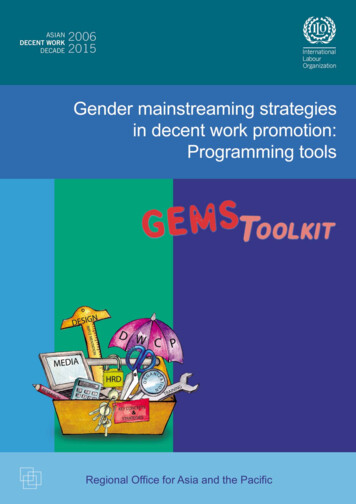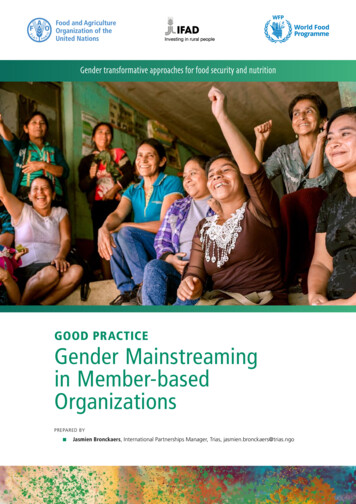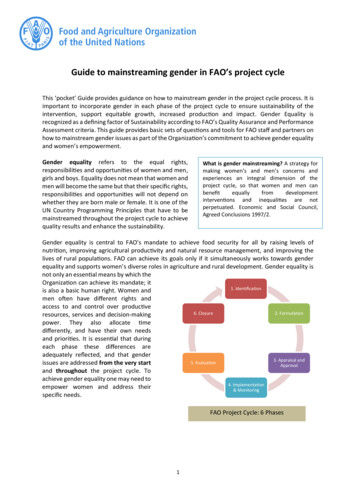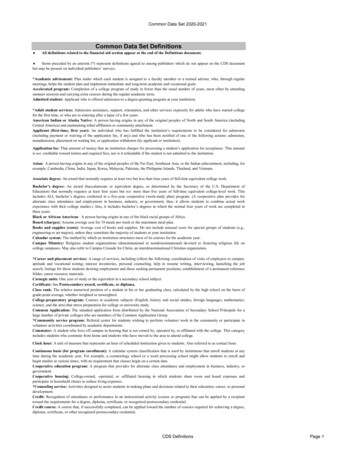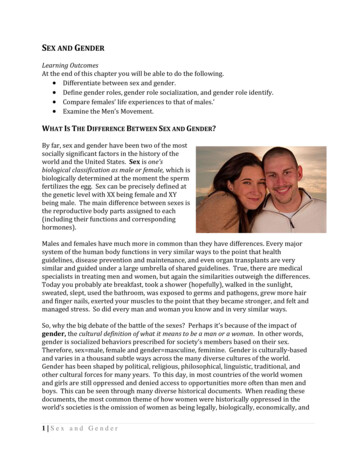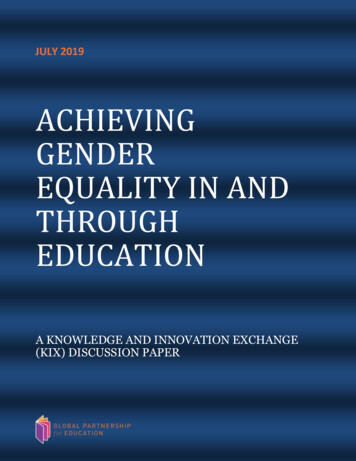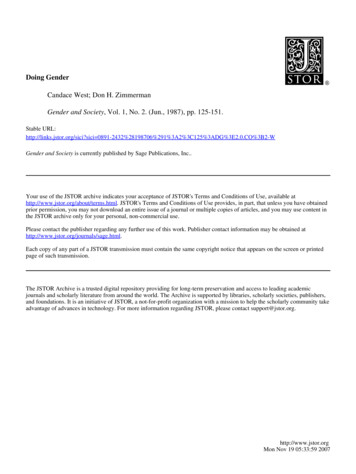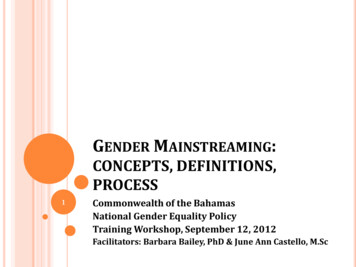
Transcription
GENDER MAINSTREAMING:CONCEPTS, DEFINITIONS,PROCESS1Commonwealth of the BahamasNational Gender Equality PolicyTraining Workshop, September 12, 2012Facilitators: Barbara Bailey, PhD & June Ann Castello, M.Sc
GENDER & DEVELOPMENT (GAD) Withthe advent of GAD, came therecognition of the importance of genderanalysis as a tool for understanding theunique needs of men and women indevelopment policies, programmes andstrategies and the need for conductinggender analyses in a systematic way. Asa result the process of GenderMainstreaming was developed.2
GENDERMAINSTREAMING3Mandate
GMS: GLOBAL MANDATEMainstreaming was clearly establishedas the global strategy for promotinggender equality through the Platform forAction at the United Nations 4th WorldConference on Women in Beijing in 1995.4
BEIJING PLATFORM FOR ACTION, 1995 . Governments and other actors should promote an activeand visible policy of mainstreaming a gender perspective intoall policies and programmes, so that, before decisions aretaken, an analysis is made of the effects on women and men,respectively.In this regard reference is made to a number of areas in whichthis should happen including, for example: inequalities in health status and unequal access to andinadequate health-care services between women and men; violence against women; women in decision-making;5 Economic empowerment of women; etc.
REGIONAL MANDATE: POST-BEIJING CARICOMPLAN OF ACTION, 1997 Inthe Regional Plan of Action two major strategicobjectives were identified to achieve greatergender equality and social justice in the region;viz.: The promotion of support for gender equityamong policy-makers and the broad publicthrough the mainstreaming of gender in (a) theculture and organization of relevant institutions aswell as in programming and policy at national leveland at the level of the CARICOM Secretariat; and,(b) in public debate and concern throughexpansion of the pre-Beijing communicationstrategy.6
BEIJING 5, 2000In The Beijing 5 outcomedocument there is a moreexplicit concern about gendermainstreaming as a means ofachieving gender equality andboth are linked to issues ofwomen's empowerment.7
GENDERMAINSTREAMING8What is It?
WHAT IS GENDER MAINSTREAMING? Premised on principles of human rights, socialjustice resulting in equitable distribution ofresources:1. Every policy and activity has agender perspective or implication;2. Policies and programmes are mosteffective when the impacts on genderare considered; and the needs andrights of all groups involved areaddressed.9
WHAT IS GENDER MAINSTREAMING? Gender mainstreaming isa strategy and process toassess - through the use of a gender analysis, whichproduces gender indicators and statistics - theimplications of planned policies and programmes. Itrecognizes the need to make the different (socialand economic) experiences of men and women anintegral dimension of the design, implementation,monitoring and evaluation of these policies andprogrammes, to ensure fair results for women/girlsand men/boys.10
WHAT IS GENDER MAINSTREAMING?In order to Mainstream Gender, one needs to take intoaccount:1. Who are the stakeholders of a policy /programme/project2. What kind of consultations need to take place andwith what groups 3.Have exhaustive ways been sought to include the perspectivesof all groups of male and female stakeholders?What are the expected impacts (positive andnegative) of the policy / programme on each groupof stakeholders?11
GENDER MAINSTREAMING12JUSTIFICATION
WHY GENDER MAINSTREAMING?A society’s well being depends on ensuring thatall its members feel that they have a stake in itand do not feel excluded from the mainstream.Every individual and all peoples are entitled toparticipate in, contribute to and enjoy civil,economic, social, cultural and politicaldevelopment in which all human rights andfundamental freedoms can be fully realized.This requires all groups, but particularly themost vulnerable, to have opportunities toimprove or maintain their well-being.13
WHY GENDERMAINSTREAMING? Gender Mainstreaming:1. is based on international human rights standards(CEDAW, Beijing Platform for Action, MDGs) anddirected to promoting and protecting these rights,whether in the social, economic, political, civil or culturalspheres (or a combination of these).1. has the ability to identify those most marginalized andexcluded in society, as a result of the gender system.2. can enhance equitable development by empoweringpeople and communities to take their own decisionsabout what development means to them and how it willbe achieved.3. is particularly useful in development planning due to itspotential to alleviate injustice, inequality and poverty.14
GENDER MAINSTREAMING STRATEGYGender Mainstreaming is a globally accepted strategyfor promoting gender equality. Mainstreaming is notan end in itself but a strategy, an approach, a means toachieve the goal of gender equality. Mainstreaminginvolves ensuring that gender perspectives andattention to the goal of gender equality are central toall activities - policy development, research, advocacy/dialogue, legislation, resource allocation, andplanning, implementation and monitoring ofprogrammes and mainstreaming.htm15
GENDER MAINSTREAMING STRATEGY DEFINITION“ the process of assessing the implications forwomen and men of any planned action, includinglegislation, policies or programmes, in all areas andat all levels. It is a strategy for making women’s aswell as men’s concerns and experiences an integraldimension of the design, implementation, monitoringand evaluation of policies and programmes in allpolitical, economic and societal spheres so thatwomen and men benefit equally and inequality is notperpetuated. The ultimate goal is to achieve gi/pdf/factsheet1.pdf16
INTER-RELATED ELEMENTS17GENDERMAINSTREAMING
INTERLINKED CONCEPTS OF GENDER, GENDERANALYSIS, GENDER MAINSTREAMING AND GENDERSENSITIVE INDICATORS HTTP://WWW.FAO.ORG/SD/2001/PE0602A EN.HTM18
GENDER MAINSTREAMING19GENDER ANALYSIS
20
GENDER ANALYSIS Genderanalysis is a strategy foridentifying the different roles andneeds of men and women in any givensituation. Throughgender analysis, plannerscan develop and implement concretemeasures to promote equality ofopportunity and treatment betweenmen and women.21
THE NEED FOR GENDER ANALYSIS Gender Analysis refers to a systematic way of looking atthe different impacts of development on women and men.It requires recording and exploring the different roles andexperiences of men and women in the developmentprocess and monitors these differences based on datasets disaggregated by sex. These data sets are knowncollectively as indicators. Gender analysis ought to be done at all stages of thedevelopment process, as it facilitates an examination ofhow a particular activity, decision or plan will affect mendifferently from women. Gender analysis explores thesedifferences so policies, programs and projects can identifyand meet the different needs of men and women. Gender22analysis also facilitates the strategic use of distinctknowledge and skillspossessed by women and men.http://www.unescobkk.org/fileadmin/user //global.finland.fi/julkaisut/taustat/nav gender/glossary.htm
TOOLS23GENDER ANALYSIS
DATA COLLECTION TOOLS Traditionalmethods – questionnaire(survey), in-depth interviews, Focus groupDiscussions (FGD); Non-traditionalmethods used incommunities – Problem wall and solutiontree, time use calendar, observations in acommunity, discussions with keyinformants etc.24
MAJOR TOOL Information/data disaggregated on theof sex at a minimum (between groupdifferences);basisMultiple subjectivities/identities –intersectionality (within group differences)25
GENDER ANALYSIS:TAKING INTO ACCOUNT THE MANY FACES OF tySESRuralEthnicitySESEthnicitySESSES26
GENDER MAINSTREAMING27THE GOAL
GENDER EQUALITY(EQUALITY BETWEEN WOMEN AND MEN)Gender equality refers to the equal rights, responsibilities andopportunities of women and men and girls and boys. Equalitydoes not mean that women and men will become the same butthat women’s and men’s rights, responsibilities andopportunities will not depend on whether they are born maleor female. Gender equality implies that the interests, needs andpriorities of both women and men are taken into consideration,recognizing the diversity of different groups of women andmen. Gender equality is not a women’s issue but shouldconcern and fully engage men as well as women. Equalitybetween women and men is seen both as a human rights issueand as a precondition for, and indicator of, sustainable peoplecentered dermainstreaming.htm28
GMS & WOMEN’S EMPOWERMENTGMS and women s empowerment - are in no way incompetition with each other The two strategies arecomplementary in a very real sense as gender mainstreamingmust be carried out in a manner which is empowering forwomen The empowerment of women concerns womengaining power and control over their own lives. It involvesawareness-raising, building self-confidence, expansion ofchoices, increased access to and control over resources andactions to transform the structures and institutions whichreinforce and perpetuate gender discrimination andinequality . Inputs to promote the empowerment of womenshould facilitate women’s articulation of their needs andpriorities and a more active role in promoting these interestsand needs. Empowerment of women cannot be achieved in avacuum; men must be brought along in the process ctsheet1.pdf29
GMS: MAIN CENTRE OF RESPONSIBILITYA national machinery for the advancement of women is the central policycoordinating unit inside government. Its main task is to supportgovernment wide mainstreaming of a gender-equality perspective inall policy areas. The necessary conditions for an effective functioningof such national machineries include: (a) Location at the highest possible level in the Government, fallingunder the responsibility of a Cabinet minister; (b) Institutional mechanisms or processes that facilitate, asappropriate, decentralized planning, implementation and monitoringwith a view to involving non-governmental organizations andcommunity organizations from the grass-roots upwards; (c) Sufficient resources in terms of budget and professional capacity; (d) Opportunity to influence development of all government policies.Source: Beijing Platform for Action #20130
CENTRE FOR RESPONSIBILITY - POA The onus for carrying the gender mainstreamingprocess forward is placed on nationalmachineries as reflected in paragraph 76 (b) and(c) where governments are encouragedto strengthen 'national machineries tomainstream the gender perspective to acceleratethe empowerment of women in all areas and toensure commitment to gender equality practices'as well as 'Provide national machineries with thenecessary human and financial resources, . sothat gender mainstreaming is integrated in allpolicies,programmes and projects.31
GENDER BUDGETINGParagraph 73 (b) points to the fact that themainstreaming process needs to start at the levelof ‘macroeconomic and social developmentpolicies and national development programmes’[#72 (a)] and therefore from the point of resourceallocations and there is therefore the need to'Incorporate a gender perspective into the design,development, adoption and execution of allbudgetary processes, as appropriate, in order topromote equitable, effective and appropriateresource allocation and establish adequatebudgetary allocations to support gender equalityand development programmes which enhancewomen 's empowerment’.32
FACILITATING FACTORS/GUIDINGPRINCIPLES33GENDERMAINSTREAMING
FACILITATING FACTORS34
BARRIERS TO GMS35
PRINCIPLES OF GENDER MAINSTREAMINGResponsibility for implementing the mainstreamingstrategy is system wide, and rests at the highest levelswithin agencies, departments, funds, and commissions;and adequate accountability mechanisms formonitoring progress need to be established. The initial definitions of issues/problems across allareas of activity should be done in such a manner thatgender differences and disparities can be diagnosed –assumptions that issues/problems are neutral from agender equality perspective should never be made.Gender analysis should always be carried out,separately or as part of existing analyses. ECOSOC Agreed Conclusions 1997/2 1.pdf36
PRINCIPLES OF GENDER MAINSTREAMINGClear political will and allocation of adequateresources for mainstreaming, including if necessaryadditional financial and human resources, areimportant for translation of the concept into reality. Gender mainstreaming requires that efforts are madeto broaden women’s equitable participation at alllevels of decision-making. Mainstreaming does not replace the need fortargeted, women-specific policies and programmes,and positive legislation; nor does it do away with theneed for gender units or focal points. ECOSOC Agreed Conclusions 1997/2 1.pdf37
GMS: IMPLICATIONS FOR IMPLEMENTATION OFTHE NGEP38
how a particular activity, decision or plan will affect men differently from women. Gender analysis explores these differences so policies, programs and projects can identify and meet the different needs of men and women. Gender analysis also facilitates the strategic use of distinct knowledge and skills possessed by women and men. 22



